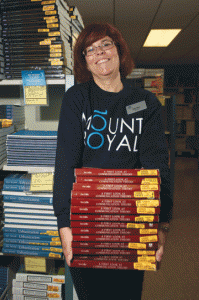Many factors in textbook cost
by Catherine Szabo
In the days leading up to the start of school, as well as the weeks fol- lowing, traffic on Main Street gets congested as students flock to the bookstore for textbooks. Michelle Toth won’t be one of those students. Last summer, the third-year

Photo by Josh Naud. Kathy Wood explained that the cost of a textbook depends on many factors, most of which are set by publishers.
human resources student start- ed the Facebook group “MRC Textbooks!” as an alternative way for students to buy and sell their course books.
“I had started this group be- cause I wanted there to be an easier and cheaper alternative to getting ripped off by the MRU bookstore,” Toth said in an email. “Us students spend a ridiculous amount of money on books each semester, and half of our classes do not even put them to good use. “Upon completion of the class the book is very often not need- ed any longer and then we sell it back for peanuts compared to what we had originally paid, whether it was new or used.”
In an email, Kathy Wood, supervisor of learning material services at the bookstore, explained that the cost of new books is set by the publisher. Nine areas are taken into ac- count when determining the price, including materials and editorial costs, author income, publisher’s administrative costs, publisher’s marketing costs, publisher’s income after tax, freight, university store costs for staff, university store insurance and miscellaneous overhead, and store income pre-tax. The materials and editorial costs are the highest, taking 32.5 cents of every dollar, and only 1.3 cents of every dollar is attributed to freight. Used books are sold for 75 per cent of the new price.
Used books can also be found in the basement of Wyckham House at Copywrite. Students set their own prices and if it sells, the student receives 75 per cent of that selling price, while SAMRU receives the other 25 per cent. In mid-August, there were 3,501 books on the shelves, and Lisa Antichow, retail manager of Copywrite, said she tries to keep a variety of options available.
“There are certain programs that tend to hang on to their textbooks, like nursing,” she said. “We have some [nursing textbooks], but not as many as you’d think for the amount of students out there.”
Introductory course books, including first-year psychology and introduction to sociology, are plentiful, as are books for business, math, sociology, psy- chology and English courses. Coursepacks, used in 65 cred- it courses and almost 100 con- tinuing education courses, can- not be sold back, however, due to their copyright.
“While many textbooks cover the necessary basic material re- quired for a course, coursepacks are based on custom material com- piled by the instructor,” Wood said in an email. “[They] are specific to that course and lectures so in most cases the entire coursepack is rel- evant to the class.”
Sometimes, if the bookstore can’t take a textbook back, either to be used on campus, shipped to another Canadian campus or sold to a wholesaler, they’ll refer the students to Copywrite. During the last school year, 3,860 books were bought from Copywrite.
“I don’t like telling students we can’t take their book,” Antichow said, noting that she had changed the layout of the store last year to accommodate more shelf space. “Unfortunately we have had to, just because we don’t want to be stuck with too many older editions, because they will just sit here.”




